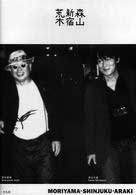MORIYAMA Daido: Difference between revisions
No edit summary |
(No difference)
|
Revision as of 02:31, 2 April 2010
MORIYAMA Daido 森山 大道 (1938.10.10- ) Ikeda City, Osaka. Internationally recognized photographer. Most noted for his photos taken in the turbulent 1960s and early 1970s. The photos were called "Bure Boke" (Shaking and Blurred) in reference to his photos' blurriness, coarse grain, and very high contrast. This rough style was his trademark which he says reflected his inner outlook and thought of people and the world. A B/W picture of an ordinary dog, one of his best-known images, looks sinister and menacing due to the high contrast and grain.
Education Dropped out of high school.
Career
Father worked for a life insurance company which required the family to move several times. Studied graphic design in high school before dropping out. Becomes a freelance graphic designer in 1958 when his father died in a train accident.
In April 1959, started working under IWAYAMA Takeji in Osaka. Moved to Tokyo in 1961 and worked as HOSOE Eikoh's assistant. In the same year, assisted Hosoe's "Barakei" (Ordeal of the Roses) photo book project featuring novelist MISHIMA Yukio.
In 1963, married and turned freelance photographer. Started to photograph Yokosuka in Kanagawa in 1964 and the photos were published in Camera Mainichi magazine the following year. Met magazine editor NAKAHIRA Takuma in 1964 who became a rival, friend, and major influence.
In 1966, besides Yokosuka, started photographing Atami, Shinjuku, and Asakusa. In the same year, opened a joint office with NAKAHIRA Takuma in Shibuya, Tokyo.
Won the Newcomer's award in 1967 from the Japan Photography Critics Association for his series on entertainment celebrities.
In 1968, joined the TAKANASHI Yutaka, TAKI Koji, NAKAHIRA Takuma, and OKADA Takahiko to work on Provoke magazine from the second issue. Their photos featured rough and grain and high contrast.
From 1969, busy with camera and documentary magazine work. In 1970, contracted to shoot the cover for Asahi Camera magazine for one year. He also was the sole artist (against his wishes) to be featured in the final issue of Provoke magazine in March 1970.
Traveled overseas for the first time in late 1971 to New York upon the invitation of painter TADANORI Yokoo. Used a half-frame camera to photograph New York.
In 1974, exhibited at the New Japanese Photography exhibition at the New York Museum of Modern Art and held his first solo exhibition at the Ginza Nikon Salon. Started teaching at a photo school in Tokyo in 1975.
In 1977, opened his own photo tutorial school in Shinjuku, Tokyo (closed in the following year). Held his first overseas solo exhibition in 1980 in Australia. After a inactive, slump period, started to photograph again in 1981.
In 1983, became one of the judges for the Nippon Camera magazine's monthly photo contest.
In 1987, opened a photo gallery called room 801 (later renamed FOTO DAIDO) in Shibuya, Tokyo (closed in 1992). Numerous photo books.
Detailed biography in English at his official Web site.
Awards Most Promising Photographer Award, Japan Photography Critics Association, 1967; Award of the Year, Photographic Society of Japan, 1983.
Book reviews
The Times of the Dog
Places in My Memory, Final Chapter
Daido hysteric No. 6,
A Journey to Nakaji
Memories
Moriyama Shinjuku Araki
 By: MORIYAMA Daido/ARAKI Nobuyoshi 森山大道/荒木経惟
By: MORIYAMA Daido/ARAKI Nobuyoshi 森山大道/荒木経惟
Published: 2005-01-15
Publisher: Heibonsha
ISBN: 4582277578
Price in Japan: Y3,675
Qualities: A4, soft cover, B/W photos
Language: Japanese and English
This is the first time these two famous Japanese photographers collaborated on a photo book and exhibition together. The photos were taken by both men on the same day in Aug. 2004 in Shinjuku, Tokyo.
They just wandered around Shinjuku and snapped away. The book also served as the exhibition catalog for their joint exhibition at Tokyo Opera City near Shinjuku during early 2005. Some 200 images are in the book. Essays are all translated into good English.
Biography in Japanese
1938:大阪府池田町宇保(現池田市)に生まれる。
1954:私立平安高校に入学。
1955:高校の二部(夜間部)へ通いながら、昼間は「展司デザイン」で勤務する。高校中退後もデザインの仕事を続ける。
1958:「展司デザイン」を辞め、短期間大阪の「矢島デザイン」でデザインの仕事に携さわったが、茨木市の自宅に仕事机を置き、フリーの商業デザイナーとして独立。
1959:岩宮武二のスタジオに入る。
1961:岩宮の紹介状を持って、「VIVO」を頼って上京。「VIVO」解散のため細江英公の助手となる。
1963:フリーランスとなり神奈川県逗子市に住まいを移す。
1964:横須賀に写真を撮りに通い続ける。
1965:横須賀の写真を当時「カメラ毎日」の編集者であった山岸章二に持ち込む。その場で「カメラ毎日」8月号に9ページ掲載が決まる。
1966:撮影地を横須賀から熱海・新宿・浅草と移し、精力的に写真を撮る。<ショウの底辺・見世物の戦後史>(「俳句」4~6月号)、<街に戦場あり>(「アサヒグラフ」9月16日~12月30日号)を寺山・森山、寺山・中平のコンビで交互に発表。東京・渋谷に中平卓馬と共同事務所開設。
1967:「カメラ毎日」に発表した一連の芸能人シリーズが評価され、日本写真批評家協会新人賞を受賞。
1968:中平に誘われて「プロヴォーグ」に第2号より参加。
1969:<アクシデント>(「アサヒカメラ」)を発表。以後この年を含めて5年間「アサヒカメラ」で連載の仕事を持つ。「カメラ毎日」「朝日ジャーナル」「太陽」「デザイン」等に精力的に写真を発表。
1970:「アサヒカメラ」表紙を1年間担当。ドキュメンタリー・タッチの新聞広告を手がける。週刊誌の広告を極彩色の大型パネルで並べたてた看板展「スキャンダル」が話題となる。「プロヴォーグ」が解散となる。
1971:<何かへの旅>(「アサヒカメラ」1~12月号)発表。<三沢の犬>をはじめ、代表作を次々に発表する。横尾忠則の誘いもあってニューヨークへ行く。
1972:「アサヒカメラ」(4月号)が、森山大道を特集。<桜花>(「カメラ毎日」6月号)を発表。
1973:<地上>(「アサヒカメラ」1~12月号)を発表。「カメラ毎日」で、当時の心情がにじみ出た日本三景シリーズを発表(12月号、翌年2・4月号)。
1974:ワークショップ写真学校開講、構成メンバーのひとりとなる。「New Japanese Photography」展(ニューヨーク近代美術館、3~5月)参加。
1975:東京写真専門学校の専任講師となり、総合写真ゼミを担当する。
1976:ワークショップ写真学校解散。新宿に「CAMP」を開設。
1977:森山大道塾開講(6月、東京・新宿。翌年3月閉講)。
1980:海外での初の個展をオーストリアのグラーツにて開催。その後1ヶ月間ヨーロッパに滞在する。
1981:北島敬三とともに「CAMP」を脱会。「写真時代」創刊、<光と影>(7月~翌年7月)を発表。<森山大道アングル'81>「毎日グラフ」10月~翌年5月)の連載開始。
1982:<犬の記憶>(「アサヒカメラ」4月~翌年6月号)の連載開始。
1983:日本写真協会年度賞受賞。「日本カメラ」のコンテストの審査を担当。
1987:ギャラリー「room・801」開設(6月、東京・渋谷。翌年7月「FOTO DAIDO」と名称を改め、92年3月閉廊)。
1988:<中平卓馬への手紙>(「文藝」春季号から連続5回)を発表。
1989:モロッコのマラケシュを訪れる。<II都物語>(「文藝」春季号から連続5回)を発表。
1990:美術館で開催された多くの写真展へ参加。
1996:<写された女たち十選>(「日本経済新聞」10月15~31日)寄稿。
1997:<犬の記憶:終章>(「アサヒグラフ」)月1回連載開始。
1998:讀賣新聞夕刊に「二都物語」を6回にわたり発表。
1999:5月15日~8月3日、写真家森山大道の足跡をたどる回顧展が、サンフランシスコ近代美術館で開催。画家大竹伸朗特集を組んだ「アサヒグラフ」11/5号に、「しなやかさと殺気とライブ感覚と"ゴリッ"としたアーティストの魅力」を寄稿。
2000:讀賣新聞夕刊「カーブミラー2000」にて写真を1年間連載。東京ビジュアルアーツ専任講師辞退、顧問となる。東京工芸大学客員教授就任。
2001:「週刊ディアス」7月16日号に、「30歳、いろんな疑問を抱えたまま、ストレートに自分をぶつけた。」(同誌age30の焦点―巨匠たちは何を見たか―)を寄稿。東京青山のシアター・イメージフォーラムにて、ドキュメント映画「≒森山大道」公開開始。
(http://www.fujifilm.co.jp/photographer/2002_09moriyama/profile.htmlより)